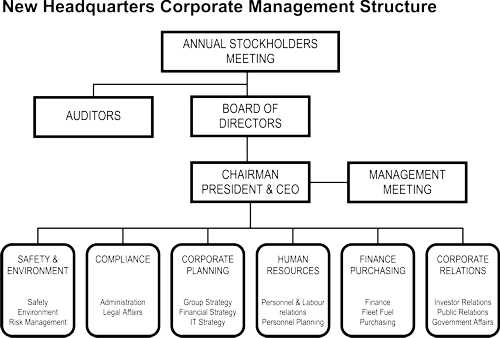| 2002 OCTOBER 2 - JAPAN AIRLINES AND JAPAN AIR SYSTEM REBORN | |||||||||||||||||||||||||||||||||
| January 28, 2002 TOKYO, January 29, 2002 -- As announced on November 12, Japan Airlines and Japan Air System have reached a basic agreement on integration of the two air transport groups through an incorporated holding company, after obtaining the necessary approvals from the government bodies concerned and the companies' shareholders. This announcement was followed on December 26 with the announcement of agreement on the stock-swap ratio of between JAL and JAS and the proposed new holding company. Today details of the organization of the new Corporate Group company are announced, together with the name of the holding company due to be established as of October 2, 2002 (phase 1 of the merger), and the key business division names to be introduced in spring 2004 (phase 2). Names are shown here in Japanese and English (in parentheses) | |||||||||||||||||||||||||||||||||
| |||||||||||||||||||||||||||||||||
| (K.K. = Kabushiki Kaisha = limited company) By radical improvements in a new corporate structure, the Japan Airlines Group will continue to maintain safety and security in flight operations. At the same time it will further develop fares and services competition and improve customer convenience in both the domestic and international networks. Domestic route focus will be on establishing a comprehensive and competitive network by improvement in transport and service quality. We will maintain and expand local route networks, contributing to activating local economies. International network development will focus on expansion within Asia. JOINT HOLDING COMPANY - JAL and JAS INTEGRATION | |||||||||||||||||||||||||||||||||
| |||||||||||||||||||||||||||||||||
| Note: Contracts for integration will be completed by April 2004 and approved at both airlines' annual general meetings of stockholders in June 2004. | |||||||||||||||||||||||||||||||||
| |||||||||||||||||||||||||||||||||
| |||||||||||||||||||||||||||||||||
| 1. New Corporate Group name and brand (name) (1) Corporate Group name: (Nihon Koku Group) English: Japan Airlines Group (2) Group brands (names) (Nihon Koku) Japan Airlines, JAL (3) Group logo - under study 2. Corporate Policy will be based on the following points (1) To pursue the world's top quality in airline safety and reliability (2) To maximize corporate value for returns to all stakeholders (3) To improve service from the customer's viewpoint (4) To be a good corporate citizen, with transparency in business (5) To establish a corporate climate based on ability and challenge. IV. GROUP STRATEGY 1. Strategic direction (1) By utilizing the maximum synergies the new organization will become a leading world airline through well-balanced operations in domestic and international business, based on JAL's operation of international routes and domestic trunk routes and domestic routes including local routes based on JAS operations. (2) The new organization will reorganize air transport related businesses from the viewpoint of efficiency, commonality, quality and low cost. (3) Associated businesses other than air transport related will be developed using synergies to maximum effect to produce strong, independent businesses. 2. Business strategy for air transport (1) International routes We will merge the international networks of both companies. A key element will be a comprehensive network serving China. We will also develop our Asian network. We will also concentrate resources on high demand routes to Europe and the U.S. We will also expand through alliances to further increase competitive power. (2) Domestic routes We will increase frequencies and also provide services on routes that are now monopoly routes of other airlines. Our aim is wider domestic network, promoting competition and customer convenience. We will increase efficiency through better scheduling and more efficient aircraft management. (3) Cargo We will improve all-cargo services by the expansion of high value added cargo transport, developing a new management organization to handle customer needs more promptly 3. Service strategy The integration process will involve a detailed review of our flight schedules with the aim of providing flights on as regular a timetable as possible and by improving flight connections. We will apply the same process to the provision of seamless services in reservations, sales and airport services. Our corporate aim is to be the airline of choice for our customers. 4. System strategy Product systemization will followed from the customer's viewpoint, involving e-business, reservations and ticketing. We will introduce IT system-supporting management tools such as ERP (Enterprise Resource Planning). | |||||||||||||||||||||||||||||||||
| |||||||||||||||||||||||||||||||||
| |||||||||||||||||||||||||||||||||
 | |||||||||||||||||||||||||||||||||
 | |||||||||||||||||||||||||||||||||
| # # # | |||||||||||||||||||||||||||||||||